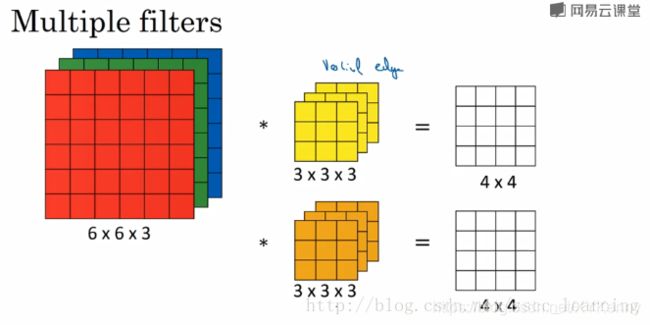【CNN系列】理解CNN中的通道 channel
思路特清晰,转自https://blog.csdn.net/sscc_learning/article/details/79814146
在深度学习的算法学习中,都会提到 channels 这个概念。在一般的深度学习框架的 conv2d 中,如 tensorflow 、mxnet ,channels 都是必填的一个参数。
channels 该如何理解?先看一看不同框架中的解释文档。
首先,是 tensorflow 中给出的,对于输入样本中 channels 的含义。一般的RGB图片,channels 数量是 3 (红、绿、蓝);而monochrome图片,channels 数量是 1 。
channels : Number of color channels in the example images. For color images, the number of channels is 3 (red, green, blue). For monochrome images, there is just 1 channel (black). ——tensorflow
其次,mxnet 中提到的,一般 channels 的含义是,每个卷积层中卷积核的数量。
channels (int) : The dimensionality of the output space, i.e. the number of output channels (filters) in the convolution. ——mxnet
为了更直观的理解,下面举个例子,图片使用自 吴恩达老师的深度学习课程 。
如下图,假设现有一个为 6×6×36×6×3 的图片样本,使用 3×3×33×3×3 的卷积核(filter)进行卷积操作。此时输入图片的 channels 为 33 ,而卷积核中的 in_channels 与 需要进行卷积操作的数据的 channels 一致(这里就是图片样本,为3)。
接下来,进行卷积操作,卷积核中的27个数字与分别与样本对应相乘后,再进行求和,得到第一个结果。依次进行,最终得到 4×44×4 的结果。

上面步骤完成后,由于只有一个卷积核,所以最终得到的结果为 4×4×14×4×1 , out_channels 为 11 。
在实际应用中,都会使用多个卷积核。这里如果再加一个卷积核,就会得到 4×4×24×4×2 的结果。
总结一下,我偏好把上面提到的 channels 分为三种:
最初输入的图片样本的 channels ,取决于图片类型,比如RGB;
卷积操作完成后输出的 out_channels ,取决于卷积核的数量。此时的 out_channels 也会作为下一次卷积时的卷积核的 in_channels;
卷积核中的 in_channels ,刚刚2中已经说了,就是上一次卷积的 out_channels ,如果是第一次做卷积,就是1中样本图片的 channels 。
说到这里,相信已经把 channels 讲的很清楚了。在CNN中,想搞清楚每一层的传递关系,主要就是 height,width 的变化情况,和 channels 的变化情况。
最后再看看 tensorflow 中 tf.nn.conv2d 的 input 和 filter 这两个参数。
input : [batch, in_height, in_width, in_channels] ,
filter : [filter_height, filter_width, in_channels, out_channels] 。


